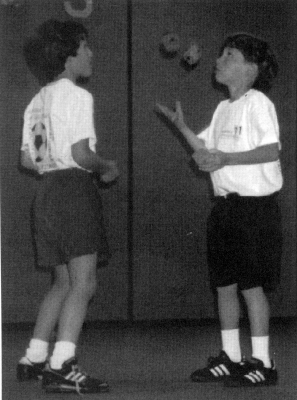
Ponderosa Jugglers in performance |

Learning more than juggling. |
Page 34 Summer 1995
|
Juggling
Lessons BY
MARION LEE CALDWELL
We
had just finished juggling practice and I was leaving Ponderosa
Elementary School with balls, clubs
"Great!"
I said. "The kids are really coming along."
"How
then, is your schooling going?" she asked, "Aren't you about
done?"
"I'll
student-teach next fall," I replied. "I'm scared though,
that there won't be jobs for new teachers with all the cutbacks. Oh
well. I might just coach juggling full time."
She
sighed, "I guess that's good. You know, not all children can
become physicists and engineers. Its good for them to have something
to do."
We
parted and I was surprised to feel anger rising in me. I know that
this particular mother could find fault in the sunrise, but still I
was offended for my students. After all, I wasn't teaching circus
skills to 20 children so they could all run away and join the circus.
Why was I teaching them?
I
teach them skills for life. My jugglers discover that they can
approach almost any complex task by breaking it down into manageable
steps. They know that learning requires taking
Together
we learn about rhythm and movement. My students experience patterns
rather than just observe them. They develop confidence and a sense of
control over their movements. Eye-hand coordination improves.
I
challenge my students to raise the ceiling of their self expectations.
At first, when introduced to a new juggling trick, some children will
say, "I can't."
"Not
yet," I tell them, "but you will." And then we get to
work. Later, when these people are faced with difficult tasks they can
remind themselves, "I learned to juggle four balls, and I thought
that was impossible!"
My
juggling students learn social skills, too. Many sports claim to
develop teamwork, but throw children into a competitive arena. In our
after-school program, though, juggling is a cooperative sport.
Students work together to improve their skills. When students learn
something new they often teach it to their teammates. When one child
has a break
Some
juggling tricks require exceptional cooperation. For example, the
"two-headed monster" is performed by two teammates standing
side by side, juggling three balls with their outside hands. In
another skill, children stand facing each other and alternate large
ball bounce-passes in a rhythmic juggling pattern. Five children in a
circle can bounce-pass up to five balls in a star pattern without
hitting. In another example, as one child juggles, another learns to
steal and replace a ball without the juggler losing a beat. I teach
six club passing
I'm
not sure Joyce would appreciate the power in learning to learn. I
might have tried a different tactic with her. For example, where else
can the laws of gravity be so finely displayed? My students know what
ball toss trajectory means. .They know that a three ball cascade
pattern follows the path of an infinity symbol. All jugglers know that
two objects cannot occupy the same space at the same time.
Often
children shine at juggling who don't shine in other school activities
or competitive sports. I've observed hyperactive children thrive in
this atmosphere of repeated motion. They practice tirelessly, soon
overtaking their peers in skill acquisition. Even children with some
physical disabilities can interact with classmates because the pace of
one childs learning doesn't hinder anothers, as with many team sports.
Students need not know English to learn how to juggle. What a great
way to integrate foreign children as they learn our language!
I'm
not really angry anymore. Six- to eleven-year-old children need to be
intimately involved with the process of learning. That's what happens
when I teach them to juggle. Besides, how many six-year-olds even know
what a physicist is?
Of
course, my juggling students may not become physicists and engineers -
but then
Caldwell
is
an IJA member who juggles with Denver's Jugglers With an Altitude
club. He has been coaching elementary school children in the
art of juggling for two years, and recently led them in their
first assembly performance. |

Ponderosa Jugglers in performance |

Learning more than juggling. |